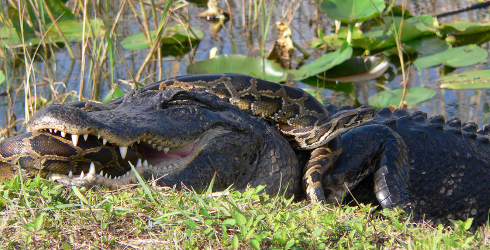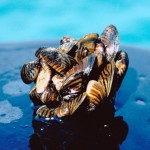 Non-native or invasive species are finding their way into ecosystems all around the world. Regardless if they are being purposefully introduced by biologists to predate on a more destructive non-native or to enhance a biological area, or if they are being released by irresponsible pet owners, non-natives threaten native species. More importantly, invasive species not only pose a risk to native plants and animals through displacement, competition, or predation, but also by the possible introduction of disease.
Non-native or invasive species are finding their way into ecosystems all around the world. Regardless if they are being purposefully introduced by biologists to predate on a more destructive non-native or to enhance a biological area, or if they are being released by irresponsible pet owners, non-natives threaten native species. More importantly, invasive species not only pose a risk to native plants and animals through displacement, competition, or predation, but also by the possible introduction of disease.
One of the most well-known stories of a non-native invasion is the cane toad of Australia.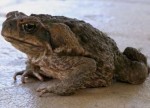 Brought to Australia in 1935, the cane toad was used to control the native cane beetle that was destroying sugar cane crops. Unfortunately, the cane toad has a veracious appetite and fed on much more than just the targeted beetle; if a cane toad can fit something in its mouth, it becomes dinner. In addition, the cane toads has glands on both sides of its head that secret a toxin that is deadly to creatures predating upon it. The keelback snake is one of only a few species that can eat cane toads without succumbing to their toxin.
Brought to Australia in 1935, the cane toad was used to control the native cane beetle that was destroying sugar cane crops. Unfortunately, the cane toad has a veracious appetite and fed on much more than just the targeted beetle; if a cane toad can fit something in its mouth, it becomes dinner. In addition, the cane toads has glands on both sides of its head that secret a toxin that is deadly to creatures predating upon it. The keelback snake is one of only a few species that can eat cane toads without succumbing to their toxin.
 In the United States the invasion of pythons and anacondas in the Everglades National Park in Florida make the news on a weekly basis. Discarded by owners or escaping from captivity, Burmese, reticulated, and African rock pythons are the most commonly found species in Southern Florida and have been documented to kill and eat everything from native rodents and birds to large deer, bobcats, and even sub-adult alligators. These snakes are non-discriminate killers eating both native predator and prey species, resulting in an unbalanced ecosystem. Furthermore, these individuals can technically pose a risk to humans, particularly children; however, no fatalities have been reported to date. This problem has escalated so much that new legislature banning the ownership and trade of these species are now being introduced into Congress. However, for Florida it isn’t only snakes that are becoming problems, wildlife officials have also added feral hogs, apple snails, monitor lizards, lion fish, purple swamphens, fire ants, and the Mexican bromeliad weevil to its Most Wanted or rather Unwanted List.
In the United States the invasion of pythons and anacondas in the Everglades National Park in Florida make the news on a weekly basis. Discarded by owners or escaping from captivity, Burmese, reticulated, and African rock pythons are the most commonly found species in Southern Florida and have been documented to kill and eat everything from native rodents and birds to large deer, bobcats, and even sub-adult alligators. These snakes are non-discriminate killers eating both native predator and prey species, resulting in an unbalanced ecosystem. Furthermore, these individuals can technically pose a risk to humans, particularly children; however, no fatalities have been reported to date. This problem has escalated so much that new legislature banning the ownership and trade of these species are now being introduced into Congress. However, for Florida it isn’t only snakes that are becoming problems, wildlife officials have also added feral hogs, apple snails, monitor lizards, lion fish, purple swamphens, fire ants, and the Mexican bromeliad weevil to its Most Wanted or rather Unwanted List.
The red-bellied pacu, a native to the Amazon River, is the vegetarian cousin of the piranha.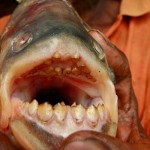 In the 1990’s wildlife officials in Papua New Guinea (PNG) introduced the pacu along with several other fish species to the Sepik and Ramu rivers to supplement the diet of indigenous people. Perhaps a good thought in the beginning, the pacu has turned into a ruthless killer expanding its diet from nuts and vegetation to fish and human flesh. Around these river systems in PNG the pacu is notorious for attacking men and biting off their testicles! As the pacu population continues to increase native fish numbers decrease. Not only is the pacu eating native fish, but it also destroys habitat by eating the vegetation that smaller river dwelling species use as food and shelter. Unfortunately, for PNG, the pacu is there to stay.
In the 1990’s wildlife officials in Papua New Guinea (PNG) introduced the pacu along with several other fish species to the Sepik and Ramu rivers to supplement the diet of indigenous people. Perhaps a good thought in the beginning, the pacu has turned into a ruthless killer expanding its diet from nuts and vegetation to fish and human flesh. Around these river systems in PNG the pacu is notorious for attacking men and biting off their testicles! As the pacu population continues to increase native fish numbers decrease. Not only is the pacu eating native fish, but it also destroys habitat by eating the vegetation that smaller river dwelling species use as food and shelter. Unfortunately, for PNG, the pacu is there to stay.
Non-native plant species can be just as or more invasive then their Anamalia counterparts.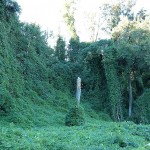 For example, kudzu, a Japanese vine, has taken over in the Southern United States, covering all that it touches, literally choking out native flora. Invasive plants can destroy native habitat by displacing or killing vegetation that native animal species depend on for survival, or be poisonous and thereby pose a threat to insects, birds, or animals that feed on them.
For example, kudzu, a Japanese vine, has taken over in the Southern United States, covering all that it touches, literally choking out native flora. Invasive plants can destroy native habitat by displacing or killing vegetation that native animal species depend on for survival, or be poisonous and thereby pose a threat to insects, birds, or animals that feed on them.
 There is no doubt that the natural world we live in is changing; either by natural selection or the misguided hand of someone with good intentions. Wildlife not only feels pressure from habitat loss, poaching, and the wild animal trade, but also from new threats within native habitat from invasive species. Wildlife professionals have a responsibility to every living creature to ensure their research is done thoughtfully and conscientiously to preserve and protect. Likewise, pet owners and facilities housing potentially invasive species are liable to make good husbandry decisions to guarantee nothing is introduced into non-native habitat.
There is no doubt that the natural world we live in is changing; either by natural selection or the misguided hand of someone with good intentions. Wildlife not only feels pressure from habitat loss, poaching, and the wild animal trade, but also from new threats within native habitat from invasive species. Wildlife professionals have a responsibility to every living creature to ensure their research is done thoughtfully and conscientiously to preserve and protect. Likewise, pet owners and facilities housing potentially invasive species are liable to make good husbandry decisions to guarantee nothing is introduced into non-native habitat.
